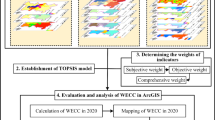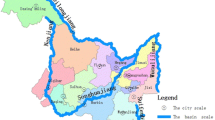Abstract
Sustainable water use of the Haihe River Basin is studied by using the ecological network analysis (ENA) approach. Two related aspects including socioeconomic and environmental water uses sustainability and network organization inherent in system structures are analyzed. For the study of sustainable water use from each single aspect including water use intensity, water use pressure, and environmental protection, a series of new indicators termed as total system throughput water use intensity (TSTUI), total system throughput pressure (TSTP), and environmental flow indicator (EFI) are set up by incorporating parameters of GDP, population, and environmental flow. Based on these three indices, a new integrated index, intensity-pressure-environment (IPE) is established for synthesized measure of sustainable socioeconomic and environmental water uses. The indices of ascendency and overhead are applied for analyzing and characterizing water use network organization. The four subbasins of the Haihe River during 1999–2002 and 2005–2007 are studied. The results show that (i) the water use intensity in subbasin II is the best, while that in subbasins I and III are the worst; (ii) subbasin II and subbasins I and III suffer the highest and lowest water use pressure, respectively; (iii) the environmental flow situations in subbasins II and III are the worst and that of subbasin I is the best; (iv) as for the integrated socioeconomic and environmental water uses sustainability, subbasin III is the best, and subbasins I and IV are the worst; (v) the organization level of subbasin I is better than the others’, in which that of subbasin IV is the worst. It can be concluded that the application of ENA in sustainable water use study can provide new angles for water resources management to address the challenges of assessing and optimizing options to obtain more sustainable water use.
Similar content being viewed by others
References
Bodini A, Bondavalli C (2002). Towards a sustainable use of water resources. International Journal of Environment and Pollution, 18: 463–485
Borrett S R, Fath B D, Patten B C (2007). Functional integration of ecological networks through pathway proliferation. Journal of Theoretical Biology, 245: 98–111
CHRBWR, Communique of Haihe River Basin Water Resources, 1999–2002 and 2005–2007 (In Chinese). www.hwcc.com.cn/haiwei/statistic/szygb.asp
Christensen V, Pauly D (1993). Trophic models of aquatic ecosystems. International Center for Living Aquatic Resources Management. Conference Proceeding Number 26. Manilla, Phillipines
Fath B D (2007). Community-level relations and network mutualism. Ecological Modelling, 208: 56–67
Fath B D, Halnes G (2007). Cyclic energy pathways in ecological food webs. Ecological Modelling, 208: 17–24
Fath B D, Patten B C (1999). Review of the foundations of network environ analysis. Ecosystems, 2: 167–179
Heymans J J, Shannon L J, Jarre A (2004). Changes in the northern Benguela ecosystem over three decades: 1970s, 1980s, and 1990s. Ecological Modelling, 172: 175–195
Ho M W, Ulanowicz R (2005). Sustainable systems as organisms. Biosystems, 82: 39–51
Li Y, Chen B, Yang Z F (2009a). Ecological network analysis for water use systems-a case study of the Yellow River Basin. Ecological Modelling, doi: 10.1016/j.ecolmodel.2009.08.007
Li Y, Yang Z F, Chen B (2009b). Ecological network analysis for water use systems: the revised model considering environmental flow and its application in the Haihe River Basin. Communications in Nonlinear Science and Numerical Simulations, in press
Patten B C, Bosserman RW, Finn J T, Cale W G (1976). Propagation of cause in ecosystems. In: Patten B C, ed. Systems Analysis and Simulation in Ecology, Vol. IV. New York: Academic Press, 457–579
Ren X S (2007). Water Resources Assessment of the Haihe River Basin. Beijing: China Waterpower Press
Rutledge RW, Basore B L, Mulholland R J (1976). Ecological stability: An information theory viewpoint. Journal of Theoretical Biology, 57: 355–371
Ulanowicz R E (1980). An hypothesis on the development of natural communities. Journal of Theoretical Biology, 85: 223–245
Ulanowicz R E (1986). Growth and Development: Ecosystems Phenomenology. New York: Springer-Verlag
Ulanowicz R E (1989). A phenomenology of evolving networks. Systems Research and Behavioral Science, 6: 209–217
Ulanowicz R E (1997). Ecology, the ascendent perspective. In: Allen T F H, Roberts D W, ed. Complexity in Ecological Systems Series. New York: Columbia University Press, 201
Ulanowicz R E (1998). Network orientors: theoretical and philosophical considerations why ecosystems may exhibit a propensity to increase ascendency. In: Muller F, Leupelt M, eds. Eco Targets, Goal Functions, and Orientors. New York: Springer-Verlag, 177–192
Ulanowicz R E, Goerner S J, Lietaer B, Gomez R (2009). Quantifying sustainability: resilience, efficiency and the return of information theory. Ecological Complexity, 6: 27–36
Ulanowicz R E, Norden J S (1990). Symmetrical overhead in flow networks. International Journal of Systems Science, 21: 429–437
Ulanowicz R E, Wolff W F (1990). Ecosystem flow networks: loaded dice? Mathematical Biosciences, 103: 45–68
Wulff F, Field J G, Mann K H (1989). Network Analysis in Marine Ecology: Methods and Applications. Coastal and Estuarine Studies 32. New York: Springer-Verlag, 284
Zorach A C, Ulanowicz R E (2003). Quantifying the complexity of flow networks: how many roles are there? Complexity, 8: 68–76
Author information
Authors and Affiliations
Corresponding author
Rights and permissions
About this article
Cite this article
Li, Y., Chen, B. Study on sustainable water use of the Haihe River Basin using ecological network analysis. Front. Earth Sci. China 3, 419–430 (2009). https://doi.org/10.1007/s11707-009-0054-0
Received:
Accepted:
Published:
Issue Date:
DOI: https://doi.org/10.1007/s11707-009-0054-0




